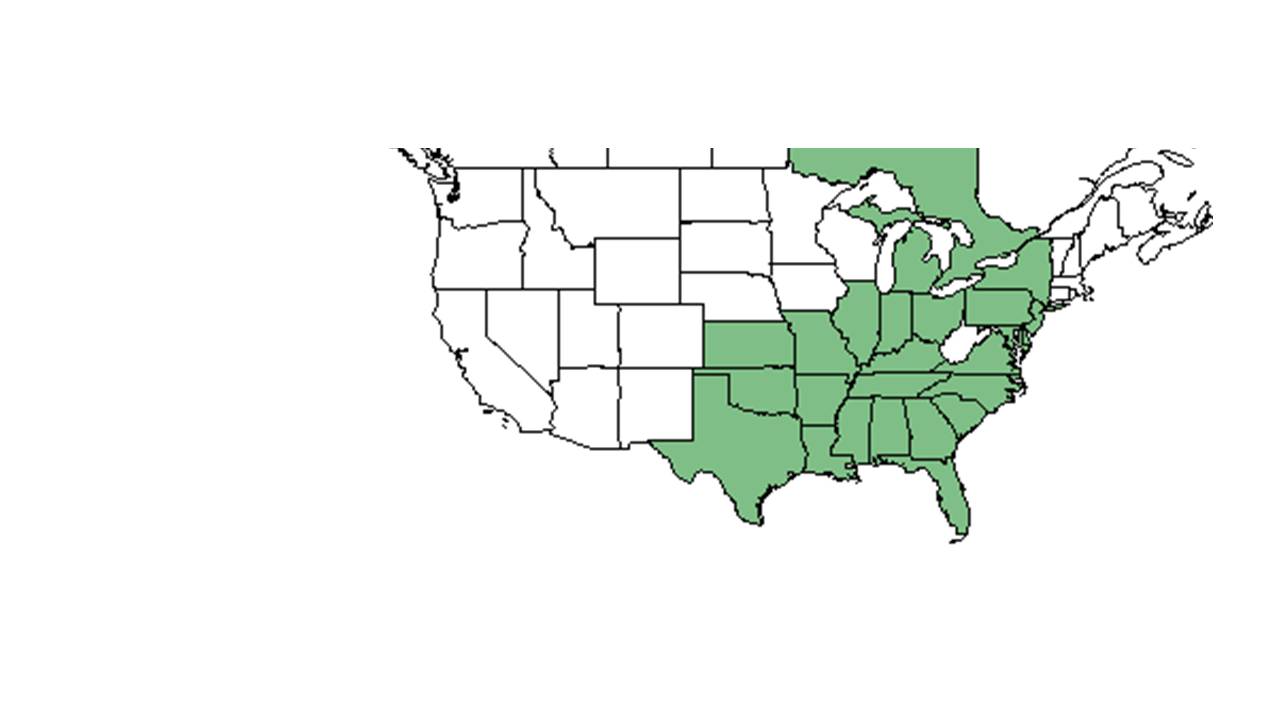Difference between revisions of "Buchnera americana"
KatieMccoy (talk | contribs) (→Distribution) |
KatieMccoy (talk | contribs) (→Distribution) |
||
| Line 26: | Line 26: | ||
==Distribution== | ==Distribution== | ||
| − | Critically imperiled in Ontario, Georgia, Virginia, North Carolina, and Indiana<ref name="natureserve"/>. | + | Critically imperiled in Ontario, Georgia, Virginia, North Carolina, and Indiana<ref name="natureserve"/>. It is the most widely distributed North American ''Buchnera'' species, and is found historically in 24 states<ref name="wildflower">[[http://www.wildflower.org/plants/result.php?id_plant=BUAM]]Lady Bird Johnson Wildflower Center. Accessed: April 4, 2016</ref>. |
==Ecology== | ==Ecology== | ||
Revision as of 16:13, 4 April 2016
| Buchnera americana | |
|---|---|

| |
| photo by Gil Nelson | |
| Scientific classification | |
| Kingdom: | Plantae |
| Division: | Magnoliophyta - Flowering plants |
| Class: | Magnoliopsida - Dicotyledons |
| Order: | Scrophulariales |
| Family: | Scrophulariaceae |
| Genus: | Buchnera |
| Species: | B. americana |
| Binomial name | |
| Buchnera americana L. | |

| |
| Natural range of Buchnera americana from USDA NRCS Plants Database. | |
Common name: American bluehearts
Contents
Taxonomic notes
Description
For the genus Buchnera, is hispid to pilose perennials with erect, simple stems growing up to 4-8 dm tall. The entire plant turns black when dried. The leaves are opposite, elliptic to ovate-lanceolate in shape, grows up to 3-7 cm long, 5-15 mm wide, and is reduced above. The leaves are entire or irregularly serrate or crenulate, sessile. The inflorescence is an open spike, the flower are in the axils of opposite bracts and subtended by 2 bractlets. The calyx tube is cylindrical, grows up to 3.5-5 mm long, the lobes 5, lanceolate in shape, slightly unequal, up to 1 mm or less long. The corolla is purple or white in color, subsalverform, weakly zygomorphic, lobes 5, shorter than the calyx tube. Up to 4 fertile stamens are present with anthers with only a single sac. The capsule is ovoid or pyriform, grows up to 5-6 mm long and is loculicidal in shape (Radford 1964).
Specifically, for Buchnera americana, they have noticeable 3-veined leaves that are ovate-lanceolate in shape. The corolla is purple in color. The calyx tube is 10-12 mm long, the lobes are 5-8 mm long. Flowers from July to September (Radford 1964).
Distribution
Critically imperiled in Ontario, Georgia, Virginia, North Carolina, and Indiana[1]. It is the most widely distributed North American Buchnera species, and is found historically in 24 states[2].
Ecology
B. americana is a hemiparasitic species, meaning that it gets nourishment from the roots of other plants, but also produces its own nourishment through photosynthesis, and can survive with out a host. Hemiparasitic plants have modified roots called haustoria, that allow it to attach to a host plant and obtain nutrients. Host for this species include: Pinus clausa, P. echinata, P. elliottii, P. palustris, P. strobes, P. taeda, Celtis laevigata, Fraxinus pensylvanica, Liquidambar styraciflua, Liriodendron tulipifera, Nyssa aquatica, N. sylvatica, Platanus occidentalis, Populus deltoids, Quercus alba, Q. falcata, and Q. shumardii[1].
Habitat
B. americana is found in moist environments near ponds and low brackish marshes, at the edges of hammocks, and in hillside bogs. However, it can also appear in drier situations like savannas, pine flatwoods, dry open woods, hillside prairies, open prairies, coastal dunes, and shallow, grassy depressions. In addition, it can be found in disturbed areas such as roadsides, ditches, sandy fields, open pastures, and clearings that have become weedy. This species prefers open, sunny conditions, but occurs in a range of soil types, from dry loamy sand, to moist black sandy peat, seasonally damp areas, acidic sandy soils, and clay soils[3].
Associated species includes slash pine, longleaf pine, saw palmetto, cypress, Hypericum opacum, Eryngium integrifolium, Xyris elliottii, Habenaria integra, Polygala ramosa, Polygala lutea, Ctenium aromaticus, Hibiscus aculeatus, Lobelia, Baccharis, Myrica, Erigeron strigosus, Polypremum procumbens, and others[3].
Phenology
B. americana has been observed flowering as early as January, through October (FSU Herbarium). Fruiting has been observed February through November (FSU Herbarium).
Conservation and Management
Cultivation and restoration
Photo Gallery
References and notes
Radford, Albert E., Harry E. Ahles, and C. Ritchie Bell. Manual of the Vascular Flora of the Carolinas. 1964, 1968. The University of North Carolina Press. 954-5. Print.
- ↑ 1.0 1.1 [[1]]NatureServe. Accessed: April 4, 2016
- ↑ [[2]]Lady Bird Johnson Wildflower Center. Accessed: April 4, 2016
- ↑ 3.0 3.1 Florida State University Robert K. Godfrey Herbarium database. URL: http://herbarium.bio.fsu.edu. Last accessed: June 2014. Collectors: George R. Cooley, R. J. Eaton, O. Lakela, R. Kral, Elmer C. Prichard, Loran C. Anderson, Norlan C. Henderson, Mabel Kral, F. H. Sargent, Carroll E. Wood, Jr., Mary Atkinson, William P. Adams, C. Jackson, R.K. Godfrey, William Lindsey, W. P. Adams, Gary R. Knight, Jane Brockmann, Jackie Patman, James D. Ray, Gary R. Knight, Jean W. Wooten, Raymond Athey, Bruce Hansen, U. T. Waterfall, Paul L. Redfearn, Jr., Charles T. Bryson, A.F. Clewell, S.W. Leonard, Samuel B. Jones, Jr., John W. Thieret, Mary Margaret Williams, D. S. Correll, Chas. C. Deam, R. B. Channel, Josephine Skehan, Delzie Demaree, D.B. Ward, S.S. Ward, H.L. Blomquist, Baltzell, Kenneth A. Wilson, Grady W. Reinert, Julie Neel, R. A. Norris, R. Komarek, Thomas E. Miller, and James R. Burkhalter. States and Counties: Alabama: Wilcox. Arkansas: Prairie. Florida: Calhoun, Citrus, Charlotte, Collier, De Soto, Dixie, Escambia, Franklin, Hamilton, Hardee, Hernando, Highlands, Hillsborough, Jackson, Jasper, Lee, Leon, Levy, Liberty, Martin, Monroe, Osceola, Okaloosa, Pasco, Polk, Sarasota, St Johns, Taylor, Volusia, and Wakulla. Georgia: Charlton, Grady, McIntosh, and Thomas. Kentucky: Coffee and Lyon. Louisiana: Jefferson-Davis. Mississippi: Clay, Forrest, Jackson, and Newton. Missouri: Cambria, Cedar, Polk, and Vernon. North Carolina: Brunswick and Carteret. Oklahoma: Payne. South Carolina: Lee. Texas: Galveston.